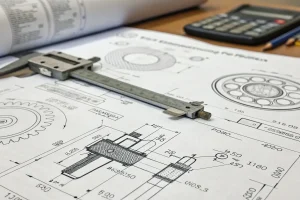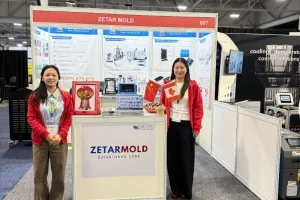Introduction:
Environmental stress cracking is a major killer of plastic parts.
To avoid the occurrence of environmental stress cracking, we need to deeply understand the mechanism behind environmental stress cracking, and then control it from three dimensions: plastic material selection, possible contact chemicals, and the stress endured by plastic parts.

Don’t wait until environmental stress cracking occurs to investigate one by one. This is not only time-consuming and labor-intensive, but may also delay project progress and product delivery dates.
What is environmental stress cracking ?
Environmental stress cracking (ESC) refers to the degradation phenomenon of plastic resin caused by the action of chemical substances in the presence of internal stress, which ultimately leads plastic part failure due to the damage of plastic components.
Environmental stress cracking is a solvent-induced damage caused by the synergistic effect of chemical substances and mechanical stresses on stress.
Environmental stress cracking is not a chemical reaction, and chemicals do not cause direct chemical attack or molecular degradation. In effect, it is the chemicals that penetrate the molecular structure and impair the internal molecular forces of the polymer chains, thus accelerating molecular breakage.

Among the common failure analysis in plastic parts,environmental stress cracking accounts for the majority, accounting for 31%, and is known as the killer of plastic parts. If chemical attacks are included, it basically accounts for 40%.
Steps and Characteristics of Environmental Stress Cracking
Steps of environmental stress cracking
The mechanical process of environmental stress cracking is similar to creep damage, which includes fluid absorption, plasticization, fine crack generation, crack propagation and final failure.
Because the environmental stress cracking process depends on the diffusion of chemicals within the molecular structure of the plastic, the rate of fluid uptake is the determining factor in both crack propagation and crack expansion rates. The faster chemicals are absorbed, the more susceptible the plastic is to cracking and consequent breakage.

Creep can be seen as environmental stress cracking that occurs under certain conditions. Creep uses air as a both chemical agent or reagent. The main difference between them is the presence of active chemical substances, which accelerates the polymer fracture process. This acceleration effect significantly shortens the initial cracking time, essentially accelerating the rate of cracking expansion, thus shortening the final damage time.
Typical characteristics of environmental stress cracking
Typical characteristics of environmentally induced cracking:
Brittle fracture:
ESC damage is caused by brittle fracture. Any material needs to produce a plastic bending fracture point under normal circumstances. As the initial cracking point of ESC damage, it generally occurs on the surface. They are often the location of high stress areas, such as microscopic defects or stress concentration points. This final cracking point is generally always in direct contact with gaseous or adsorbed active chemicals.
Initialization cracking:
Initialize multiple single-point cracking and then connect into a unified fracture. The batch of original cracking and union is the portrayal of ESC acquisition.
Smooth form:
The original cracked area usually exhibits a relatively smooth form and slowly cracks and expands. Active chemicals can accelerate the initial cracking and cracking expansion. This phenomenon is especially obvious on rough surfaces.
Remaining fine cracks:
The presence of residual fine cracks, whether in the initial cracking area or in nearby areas, will indicate the occurrence of ESC. In many cases when the crack length reaches a critical size, final failure will occur during plastic deformation overloading.

Stretching fibrils:
Stretching fibrils and other features may appear in the final fracture zone, indicating that the fracture is a plastic fracture. This is an important implication that chemical mechanisms of action in ESC are inappropriate and therefore the accompanying chemical degradation of molecules is usually absent.
Crossbands:
Latest experiments show that general ESC proceeds through a progressive cracking propagation mechanism. Reshaping characteristic surface tests under laboratory conditions revealed a series of crossbands, equivalent to rings leading to cracking propagation. These observed bands can be imagined as repeated rings of graining, followed by cleavage propagation through brittle cracking, which involves steps in the creep and ESC failure mechanisms.
Factors affecting environmental stress cracking
Environmental stress cracking is mainly related to the following three factors:
Type of plastic material;
Chemical substances in contact with plastic parts;
Stress acting on plastic parts;
plastic type
Generally speaking, amorphous plastics are more susceptible to environmental stress cracking than semi-crystalline or rigid plastics. This is due to the large free volume of amorphous plastics compared to the ordered, dense structures of semi-crystalline plastics. Therefore, amorphous plastics such as PC, ABS, PPO, PMMA, etc. are more prone to environmental stress cracking than PBT, POM, PA66, PPS, etc. Of course, even if the same plastic has different compositions, its ESC resistance will be different.
Molecular weight:
As the molecular weight of the plastic decreases, the ability to resist ESC decreases. Likewise, for a given substance, the phenomenon of tie molecules degradation decreases with molecular weight. As the number of molecular branches increases, the molecular weight of the resin increases, which gives it extraordinary critical strain ESC resistance.
Lower crystallinity:
In semi-crystalline plastics, crystallinity will significantly improve ESC resistance. Generally speaking, the higher the crystallinity, the corresponding density increases, so the ESC resistance is improved.
chemicals
Hydrogen bonding: Medium-level hydrogen bonding is a type of chemical that can easily aggravate the occurrence of ESC. For example, organic esters, ketones, aldehydes, aromatic hydrocarbons and chlorinated hydrocarbons are chemicals with stronger ESC effects than organic alcohols.
Molecular size: Chemical reagents with lower molecular weights tend to aggravate the occurrence of ESC. For example, silicone oil is stronger than silicone grease, and acetone is stronger than methyl isobutyl ketone. This conclusion is directly drawn from the molecular size, and smaller molecules have greater ability. Penetrate into the polymer molecular structure.
There are two main sources of chemicals;
During the production process:
release agents in the injection molding process, various greases in the injection molds, etc., plastic parts will encounter chemical substances during secondary processing such as electroplating, spray painting, silk screen, etc., as well as during packaging and transportation. to chemicals.

During use:
The parts of the accessory are attached with chemical substances during the production process, or there are chemical substances in the use environment, such as glue, detergent, lubricating oil, etc.
stress
Tensile stress endured during use:
ESC will only occur when the material is in a state of tensile stress. Tensile stress is the reason why molecules break and ultimately cause ESC. Compressive stress is enough to cause mechanical failure of plastic parts under certain environmental conditions, but not enough to cause ESC.
Residual internal stress in the injection molding process:
Internal molding residual stress combines with external stress to cause ESC. The huge molding residual stress is enough to cause ESC.
Stress generated during assembly, such as ultrasonic welding, vibration welding, hot melting and screw tightening.
Countermeasures and suggestions for stress marks on the surface of plastic parts
Material strategies
Choosing the right plastic raw material is the first solution to avoid stress marks. Plastic raw materials with high quality, high toughness and high fluidity should be used to improve the toughness and elastic modulus of the product and reduce stress concentration.

Design strategies
During the product design process, the structure should be designed rationally and the product balance should be controlled based on material characteristics, manufacturing processes and other factors to avoid stress concentration and stress marks. At the same time, attention should also be paid to controlling the wall thickness, angle, radius and other factors of plastic parts, especially at the edges and joints of the product, a uniform wall thickness design should be maintained to increase the uniform force distribution of the product.
Production process strategies
Adopting a suitable molding process is the key to avoiding stress marks. The quality of the mold should be ensured, the temperature during the molding process should be controlled to be uniform, and parameters such as molding speed, pressure, and field direction should be well controlled to avoid excessive traction, stretching, etc. At the same time, attention should be paid to corresponding adjustments to changes in the molding process during the production process to ensure a smooth transition at each transition point.

Transportation, loading and unloading strategies
During the transportation, loading, unloading and installation of plastic parts, care should be taken to avoid improper grasping and excessive pressure. Factors such as force size and direction should be grasped to prevent stress concentration and stress marks caused by human factors.
Methods to prevent surface stress marks
In addition to the above countermeasures, the following methods can also be used to prevent the occurrence of stress marks on the surface of plastic parts:
Use mold optimization design to increase control of hot runner and product thickness to avoid stress concentration and stress marks caused by plastic fatigue;
Strengthen product quality management to ensure that each product meets the requirements in terms of quality and appearance;
Purchase appropriate testing equipment to detect problems during the production process, and repair or replace damaged parts in a timely manner;
Pay attention to the use of plastic parts at any time, solve problems in time, and ensure that there are no stress marks when the product is used for a long time.
Conclusion
The existence of stress marks on the surface of plastic parts will seriously affect the aesthetics and stability of the product. Therefore, special attention must be paid to the causes and countermeasures during the production process. Through the introduction of this article, I believe that readers have understood the causes and countermeasures of stress marks on the surface of plastic parts. Taking preventive measures can avoid the problem of stress marks during the use of plastic parts.










